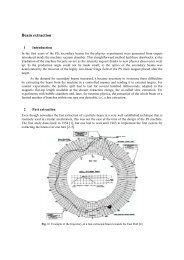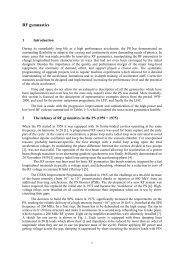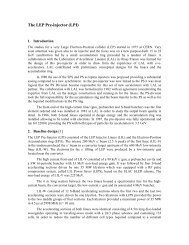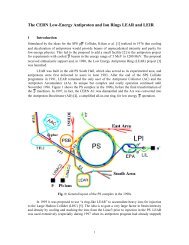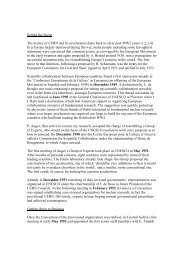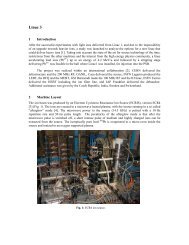Beam extraction - 50th anniversary of the CERN Proton Synchrotron
Beam extraction - 50th anniversary of the CERN Proton Synchrotron
Beam extraction - 50th anniversary of the CERN Proton Synchrotron
Create successful ePaper yourself
Turn your PDF publications into a flip-book with our unique Google optimized e-Paper software.
Fig. 35: Transverse pr<strong>of</strong>ile <strong>of</strong> <strong>the</strong> beamlets before <strong>extraction</strong> (left) and intensity signal <strong>of</strong> a pick-up in<br />
<strong>the</strong> PS–SPS transfer line <strong>of</strong> <strong>the</strong> extracted beam<br />
The rest <strong>of</strong> <strong>the</strong> commissioning period in 2008 was devoted to <strong>the</strong> preparation <strong>of</strong> <strong>the</strong> operational<br />
magnetic cycle, <strong>the</strong> study <strong>of</strong> <strong>the</strong> <strong>extraction</strong> with multi-bunch beam, and <strong>the</strong> determination <strong>of</strong> <strong>the</strong> most<br />
suitable longitudinal structure to be injected in <strong>the</strong> SPS. This has been ano<strong>the</strong>r crucial point <strong>of</strong> <strong>the</strong> study.<br />
The beamlet formation, in fact, is not sensitive to <strong>the</strong> number <strong>of</strong> bunches in <strong>the</strong> machine, but it is sensitive<br />
to <strong>the</strong> beam momentum spread, since via chromaticity a large momentum spread creates a large tune<br />
modulation, inducing trapping/de-trapping phenomena and reducing <strong>the</strong> capture efficiency. The losses at<br />
<strong>extraction</strong>, however, depend on <strong>the</strong> bunch spacing due to <strong>the</strong> finite rise time <strong>of</strong> <strong>the</strong> kickers. In particular,<br />
<strong>the</strong> kicker rise time is longer than <strong>the</strong> h=8 PS bunch spacing, <strong>the</strong> rise time being about 350 ns and <strong>the</strong><br />
bunch spacing about 260 ns. This implies that a fraction <strong>of</strong> <strong>the</strong> beam will be intercepted by <strong>the</strong> <strong>extraction</strong><br />
septum during <strong>the</strong> kicker rise. The situation becomes worse if <strong>the</strong> h=16 harmonic is preferred or if <strong>the</strong><br />
beam is de-bunched: <strong>the</strong> losses are nearly doubled going from 0.6% <strong>of</strong> <strong>the</strong> circulating intensity for h=8 up<br />
to 0.9% and 1% for <strong>the</strong> h=16 and de-bunched cases, respectively [44]. A detailed series <strong>of</strong> studies has<br />
been made by injecting a beam in <strong>the</strong> SPS with different longitudinal structures from <strong>the</strong> PS and assessing<br />
<strong>the</strong> dependence <strong>of</strong> <strong>the</strong> losses as a function <strong>of</strong> <strong>the</strong> harmonic number and <strong>of</strong> <strong>the</strong> RF voltage at <strong>extraction</strong>.<br />
The conclusion was that a de-bunched beam is <strong>the</strong> most suitable for <strong>the</strong> SPS, even if this choice does not<br />
minimize <strong>the</strong> losses in <strong>the</strong> PS. Hence, a MTE de-bunched <strong>extraction</strong>, see Fig. 36 (left), was prepared after<br />
<strong>the</strong> end <strong>of</strong> <strong>the</strong> 2008 SPS run, increasing <strong>the</strong> extracted intensity to 1.4×10 13 protons. The <strong>extraction</strong><br />
efficiency, expected to be up to 97–98 %, turned out to be on average about 93%, but with peaks up to<br />
99%. These fluctuations were correlated with beam instability due to a slightly negative value <strong>of</strong> <strong>the</strong><br />
chromaticity just prior to <strong>the</strong> resonant crossing. For <strong>the</strong> nominal <strong>extraction</strong> case, with an efficiency <strong>of</strong><br />
about 98%, <strong>the</strong> beam loss pattern was compared with <strong>the</strong> five-turn <strong>extraction</strong> currently in use [48]. As<br />
expected, (see Fig. 36, right), <strong>the</strong> MTE beam losses are concentrated in <strong>the</strong> <strong>extraction</strong> region, whereas for<br />
<strong>the</strong> CT, losses <strong>of</strong> typically 5–6% <strong>of</strong> <strong>the</strong> circulating intensity are spread out over <strong>the</strong> entire machine<br />
circumference [48]. These losses are generated by <strong>the</strong> interaction <strong>of</strong> protons with <strong>the</strong> blade <strong>of</strong> <strong>the</strong><br />
electrostatic septum in SS31. Moreover, particles scattered at <strong>the</strong> septum generate losses in <strong>the</strong> region<br />
between SS40–45 and SS72–76.<br />
During <strong>the</strong> last part <strong>of</strong> <strong>the</strong> CNGS run, it was possible to inject a MTE, h=16 bunched beam in one<br />
<strong>of</strong> <strong>the</strong> CNGS SPS cycles. The total intensity injected was about 1.4×10 13 protons. The two batches, each<br />
one <strong>of</strong> about 0.7×10 13 protons, had <strong>the</strong> last PS ejected turn with a larger intensity than <strong>the</strong> o<strong>the</strong>r four. The<br />
proton beam in <strong>the</strong> SPS could be injected, accelerated, and extracted towards <strong>the</strong> CNGS target. Neutrinos<br />
were also produced during <strong>the</strong> last night <strong>of</strong> <strong>the</strong> 2008 CNGS run.<br />
30



